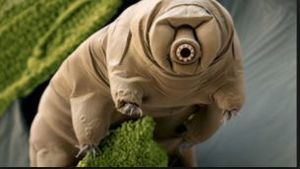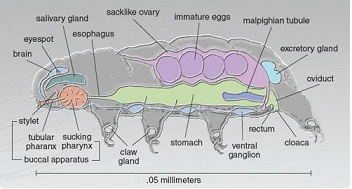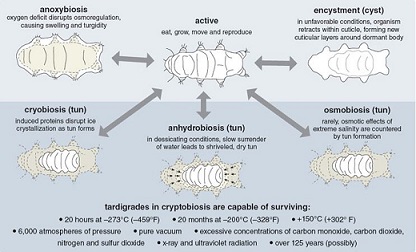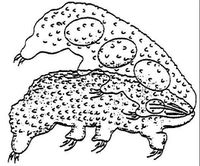Tardigrades

Tardigrades
Tardigrades are microscopic invertebrates who typically live in moss, lichen, leaf litter, soils, and aquatic environments. Their name is loosely translated to “slow walker” as they walk slowly on small stubbly legs often attaching themselves to debris [9]. The body lengths of tardigrades are generally less than 1 mm and they lack a dorsal heart, circulatory system, and respiratory system [11]. Despite their differences in morphology from sister taxa, tardigrades have the ability to thrive in a diversity of habitats. Their widespread presence is partially attributed to their ability to enter a cryptobiotic state. In this state, metabolic activities stop and tardigrades enter a lifeless form until conditions are more favorable. This cryptobiotic state can be induced by anhydrobiosis, osmobiosis, anoxybiosis, cryobiosis and more [5]. The ability of tardigrades to withstand extreme environments including the vacuum of a space has given them much attention in research.
Morphology

Tardigrades fall under the phyla of ecdysozoans, as they are encased in a cuticle which they shed as they grow [9]. They have five body sections including their head, and each body section is fitted with two claws; totaling eight. They also have a complete digestive system with a sucking pharynx which leads to an esophagus, stomach, intestine, and anus. Tardigrades have a dorsal brain with a ventral nervous system which supports a variety of complex sensory functions including light-sensitive eyes [8]. Additionally, tardigrades are equipped with a hemocoel, or a body cavity, that touches every cell eliminating the need for circulatory and respiratory systems and directly allowing for nutrition and gas exchange.

Physiology
Tardigrades are one of the few species to be found on all continents, withstanding many sorts of extreme environmental conditions. Survivorship in tardigrades is attributed to their ability to enter a cryptobiotic state. While many tardigrades possess the ability to enter this lifeless state, those that dwell in relatively stable marine and aquatic ecosystems have not evolved these characteristics [9]. Research has shown that survival adaptations are primarily a response to changing conditions in terrestrial environments. Terrestrial dwelling tardigrades have three states of being known as active, anoxybiosis and cryptobiosis. An active state is a normal way of life in which tardigrades carry out their typical routines. In an anoxybiotic state, oxygen levels are low and osmoregulatory controls begin to fail which causes tardigrades to puff up and float around. Finally, a cryptobiotic stage is an ametabolic state in which a tardigrade becomes dormant until conditions are more favorable. This state can be induced by desiccation (anhydrobiosis) , freezing (cryobiosis), exposure to extreme salinity (osmobiosis), lack of oxygen (anoxybiosis), and other extreme conditions [5]. Anhydrobiosis is common for tardigrades and they can return to their active state in a few minutes to hours after they are rehydrated by precipitation. In cryobiois, if a tardigrade is exposed to temperatures below the freezing point of its cytoplasm, metabolism is suspended. The release of cryoprotectants alter the freezing temperature of tissues allowing for a slower transition into cryobiosis [10]. During exposure to extreme salinities, tardigrades may curl up into a dry husk known as a “tun”. Recent research has proven that tardigrades are able to withstand temperatures of -272.8 degrees Celsius, a temperature at which atoms come to a complete standstill. Tardigrades have even been shown to survive the vacuum of space and serve as a model for research into surviving space conditions [1,6,7].

Reproduction
Tardigrades can reproduce via various methods. Some tardigrades are parthenogenic, meaning they are able to produce eggs without mating. Others are hermaphroditic, meaning that they possess the ability to self-fertilize. Some are capable of sexual reproduction. Parthenogenic tardigrades produce offspring which develop from gametes. Parthenogenesis can operate on a haploid or a diploid cell and allow for colonization of a new territory by a single individual [3]. Hermaphroditism was once thought to be the least common form of reproduction in tardigrades, but has now been found in four of five of the families of eutardigrades [2]. Self-fertilization appears in species in freshwater, mosses, leaf litter, soils and occasionally in marine species [3,4]. During sexual reproduction, a female will lay eggs during her molting period. These eggs are laid inside the outer layer of a tardigrade’s cuticle. A male will approach the female from behind and ejaculate into the female’s outer layer of skin and fertilization takes place externally.
References
[1] Arakawa, K., & Blaxter, M. (2018). Tardigrades in space. Biologist.
[2] Bertolani, R. (1979). Hermaphroditism in tardigrades. International Journal of Invertebrate Reproduction, 1(1), 67–71. https://doi.org/10.1080/01651269.1979.10553300
[3] Bertolani, R. (2001). Evolution of the Reproductive Mechanisms in Tardigrades –A Review. Zoologischer Anzeiger, 240(August 2000), 247–252. https://doi.org/10.1078/0044-5231-00032
[4] Bingemer, J., Hohberg, K., & Schill, R. O. (2016). First detailed observations on tardigrade mating behaviour and some aspects of the life history ofIsohypsibius dastychiPilato, Bertolani & Binda 1982 (Tardigrada, Isohypsibiidae). Zoological Journal of the Linnean Society,178(4), 856-862. doi:10.1111/zoj.12435
[5] Hengherr, S., Worland, M. R., Reuner, A., Brummer, F., & Schill, R. O. (2009). Freeze tolerance, supercooling points and ice formation: comparative studies on the subzero temperature survival of limno-terrestrial tardigrades. Journal of Experimental Biology, 212(6), 802–807. https://doi.org/10.1242/jeb.025973
[6] Jönsson, K. I. (2007). Tardigrades as a Potential Model Organism in Space Research. Astrobiology, 7(5), 757–766. https://doi.org/10.1089/ast.2006.0088
[7] Jönsson, K. I., Rabbow, E., Schill, R. O., Harms-Ringdahl, M., & Rettberg, P. (2008). Tardigrades survive exposure to space in low Earth orbit. Current Biology. https://doi.org/10.1016/j.cub.2008.06.048
[8] Miller, W. R. (2004). Tardigrades. Bears of the Canopy. In Forest Canopies: Second Edition (pp. 251–258). https://doi.org/10.1016/B978-012457553-0/50018-6
[9] Miller, W. R. (2011). Tardigrades. American Scientist, 99(5), 384–391. https://doi.org/10.1511/2011.92.384
[10] Møbjerg, N., Halberg, K. A., Jørgensen, A., Persson, D., Bjørn, M., Ramløv, H., & Kristensen, R. M. (2011). Survival in extreme environments - on the current knowledge of adaptations in tardigrades. Acta Physiologica (Oxford, England). https://doi.org/10.1111/j.1748-1716.2011.02252.x
[11] Schmidt-Rhaesa, A. (2001). Tardigrades -- Are They Really Miniaturized Dwarfs? Zoologischer Anzeiger - A Journal of Comparative Zoology, 240(3–4), 549–555. https://doi.org/10.1078/0044-5231-00066
[12] 